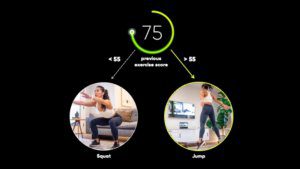The 1950s brought us exercise on TV—and home equipment so we could follow along.
Now, 70 years later, it’s fair to say this is the golden age of connected fitness, with Peloton, Nautilus and more riding the highs (and lows) of the pandemic.
Stock prices aside, the fitness and wellness industry seems to have made significant progress in recent decades. Unfortunately, that progress is an illusion.
Consider fitness technology, for starters. Most at-home workouts are, by and large, non-interactive and non-adaptive—just like they were in the 1980s.
Granted, the tech has advanced to the point where users can choose Apple workouts directly on their set-top box. But the experience is only one step removed from browsing a home library of Jane Fonda workout tapes.
So-called “connected” equipment represents another disappointment. Bluetooth or WiFi may enable it, but it pays only lip service to user levels or goals—and certainly can’t adapt to shape to performance.
The Personalization Problem
The problem is this: what passes for personalization in the fitness and wellness industry isn’t very personalized at all.
At the most basic level of personalization, users may experience a variety of choice— “personalizing” their workout by choosing different programs or workouts that seem relevant.
Some users may benefit from the next level: profile-matching. Questions about user goals and workout preferences can help adapt a fitness regime to an individual, but the questions are too generic to be helpful. Nor do they take into account a user’s fitness level—if a user says they’re training for a marathon but they struggle to get up the stairs, they’re headed for trouble.
Clickstream data can power a recommendation engine, helping users simulate something that feels like a personalized workout. (“Finished Level One? Try Level Two next!”) But the reality is that kind of personalization is only simulated. Clickstream data can only track what users clicked on—not how well they exercised, whether they’re actually ready for the next level, or even whether they exercised at all.
At Kemtai, however, we’re proud to say that we’re embracing an entirely new level of personality—using computer vision technology.
How Kemtai and Computer Vision Create Adaptive Personalization
Computer vision has matured for some use cases: image search, facial recognition, self-driving cars, and so on. But the fitness and wellness industry seems to have been left behind.
Until now, that is. As companies like Kemtai drive computer vision technology, the possibilities for fitness and wellness get more and more intriguing.
Kemtai is a digital exercise company focused on providing a personalized and adaptive home exercise experience using computer vision. We realized that although there are many types of online video exercises, none of them provided the kind of feedback you get from a personal trainer or therapist.
So we developed advanced, proprietary technology that can run on laptops, phones and tablets—no 3D cameras or video-game-style gimmicks necessary. And because Kemtai tech collects information about dozens of points on the body, our computer vision models significantly increase joint detection accuracy.
That accuracy could enable immediate feedback and adaptive personalization—helping users instantly correct their posture and motion through hundreds of different exercises.
That helps Kemtai move past basic Netflix-style personalization to shape a user’s performance.
How well did they perform an exercise? How difficult was it? Did they make mistakes? And what should they do next? Kemtai’s computer vision and adaptive personalization technology can answer all these questions and more.
This is where the fitness wellness market is going—and where it should be going.
And it means that an exciting development—the idea that fitness and wellness tech can natively provide the right service, the right exercise, and the right treatment to users at the right moment—is just around the corner.




